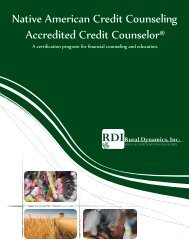Urban Indian Policy Roundtable - Rural Dynamics
Urban Indian Policy Roundtable - Rural Dynamics
Urban Indian Policy Roundtable - Rural Dynamics
You also want an ePaper? Increase the reach of your titles
YUMPU automatically turns print PDFs into web optimized ePapers that Google loves.
<strong>Roundtable</strong> II: Helena<br />
Facilitator: Jolene Bach<br />
Participants: Joyce Silverthorne, Bob Parisien, Casey Barrs, Scott Davis, Christina Davis,<br />
Bonnie Stevens, Micah Jalloh, Harmony Wolfe<br />
In the area of education, participants located four different issues concerning urban <strong>Indian</strong> students and their<br />
educational attainment. First, the discussion centered on grassroots efforts to move students from secondary<br />
to post-secondary education. The group identified the need for not only the involvement of community<br />
leaders, but also greater initiative on behalf of the parents and kids themselves, emphasizing the element of<br />
self-determination. Second, the group discussed the need to bridge gaps to economic well-being for urban<br />
<strong>Indian</strong> students through supports such as the Low Income Home Energy Assistance Program (LIHEAP)<br />
and Supplemental Nutrition Assistance Program (SNAP). Third, the group expressed support for the reform<br />
of compulsory education standards and noted that K-12 completion should be the standard rather than age<br />
demographics. Last, they discussed means for mobilizing organizations and coalitions around such legislation.<br />
Recommendations<br />
1.<br />
2.<br />
Ensure urban <strong>Indian</strong> students are enrolled in any other support programs for which they may be eligible (e.g.<br />
LIHEAP, SNAP), as a means of bridging any gaps to their academic success.<br />
Desired outcome statewide: Taking advantage of public benefits, urban <strong>Indian</strong> students will have a greater<br />
opportunity to focus on academic achievement.<br />
Support efforts to reform compulsory education standards, requiring enrolment from age 6 to 17.<br />
Desired outcome statewide: Reduction of truancy, and possible delinquent behavior, among urban <strong>Indian</strong><br />
youth. This is coupled with an increase in the rates of educational attainment, which is demonstrated as an<br />
area of need in the demographic data presented in this report.<br />
“Compulsory education creates a culture of family-supported<br />
education. Enrolling in kindergarten and first grade is not a<br />
student choice, it is a family choice.”<br />
Joyce Silverthorne (Salish),<br />
Montana Office of Public Instruction<br />
15



